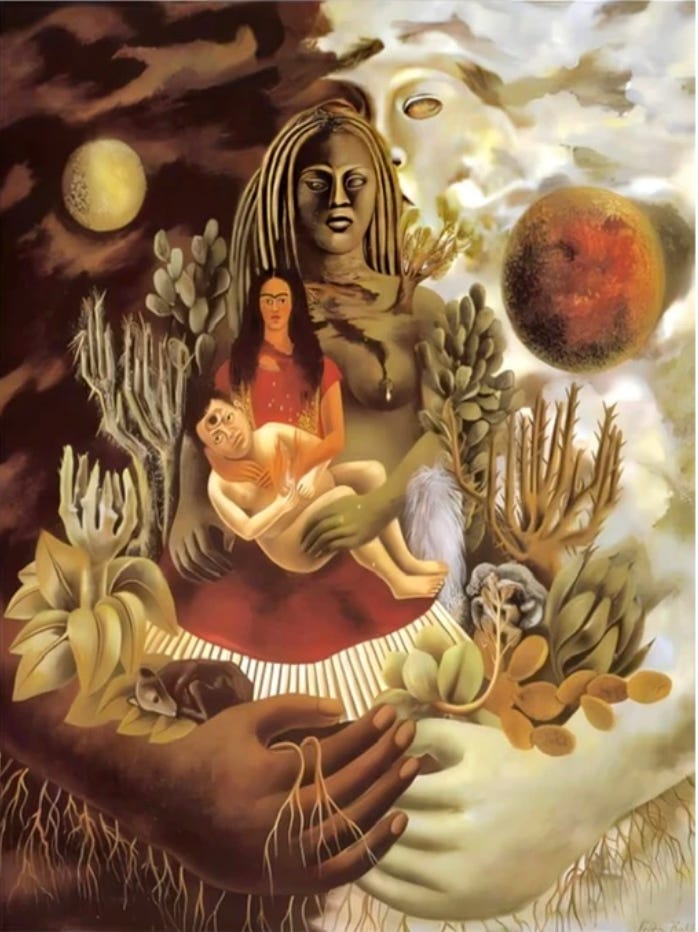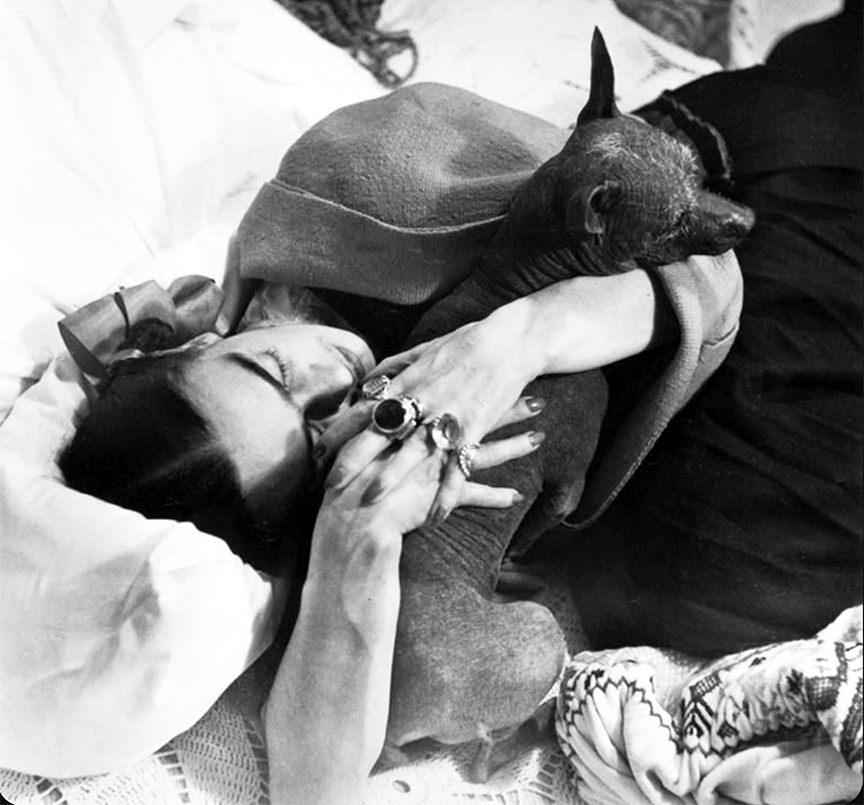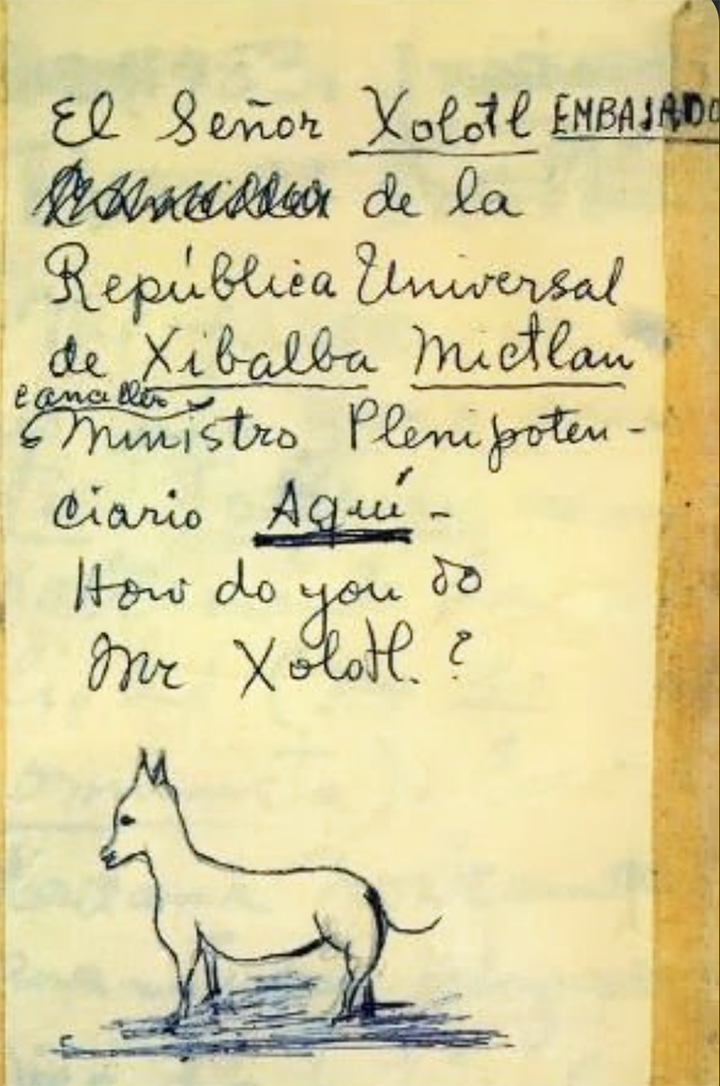I have been painting dogs for over 25 years. I am a dog biographer: a painter of their faces and the storyteller of their lives. While working on a portrait, I want to know about the dog I am painting.
When I see a dog in a painting in a museum, gallery, or online, I also want to know who the dog is and why the artist painted them.
In this spirit, I am beginning a new series to introduce you to the dogs in art history. Starting with an artist that probably most of you know:
Frida Kahlo (July 6, 1907 – July 13, 1954)
Frida has become one of the most popular artists in the world. In November 2021, one of her later self-portraits, “Diego and I” (1954), sold for a record-breaking $34.9 million, making it the most expensive artwork by a Latin American artist.
Frida has become more than an artist; she is a pop culture icon. There are so many dimensions to Frida: her childhood, the near fatal bus accident that changed her life, her politics, her friendships, her complicated marriage to fellow artist muralist Diego Rivera, her love affairs with men and women, her clothes, her jewelry, her hairstyles, and even her mustache and unibrow. That long list doesn’t even include her art.
How Frida became an artist
Born in Coyoacán, Mexico, in 1907, Frida contracted Polio at age 6, which resulted in a shortened right leg. In 1925, at age 18, while riding a bus, a tram (trolley car) collided with the bus. Many people were killed; Frida survived. However, her spine was fractured in three places, her right leg was shattered into 11 pieces, her right foot was crushed, her collarbone and two ribs were broken, and her shoulder was dislocated. Additionally, her pelvis was fractured and her abdomen and uterus punctured by a metal handrail which exited through her vagina.
After a month in the hospital, these debilitating injuries required months of bed rest. As a distraction from the boredom and pain, she taught herself to paint using a mirror over her bed and a special easel. Frida began to paint what she saw in the mirror, her emotions, and her painful body. Throughout her life, she had over 30 surgeries, wore medical corsets, and explored alternative methods to help with the chronic pain.
Her first self-portrait was completed when she was 18 and given as a gift to her then-boyfriend. Among her 143 paintings, 55 are self-portraits. Her paintings became her biography.
She did not think she would become an artist; Frida planned on studying medicine.
Meet Señor Xolotl
Frida was born, lived her entire life, and died in the Blue House, La Casa Azul, in Mexico City. When she married Diego Rivera, they shared the home with a menagerie of animals. The menagerie included Fulang Chang and Caimito del Guayabal, both spider monkeys; Bonito, an Amazonian parrot; Granizo, a fawn; Gertrudis Caca Blanca, a bald Eagle; and her three Xoloitzcuintli dogs, also called Xolos and the Mexican Hairless Dog.
Xoloitzcuintlis are one of the oldest domesticated dog breeds. The remains of one were found at an archaeological site dated about 5,500 years ago.
The breed's name, Xoloitzcuintli, highlights their significance in Mesoamerican history and cultures. It is a combination of the word itzcuintli, which in the Aztec language of Nahuatl means dog, and the word xolotl, which means the god of death. Xoloitzcuintli were considered sacred, could ward off evil spirits, and guide their person to the afterlife. Today, Xolos continue to play a significant role in celebrating the Day of the Dead.
Frida named her first Xoloitzcuintli Señor Xolotl, meaning Mr. guardian of the underworld.
Xolos have appeared in the art of Mesoamerican cultures of Western Mexico for over 3,000 years.
Señor Xolotl appears in Frida’s diary.
She wrote that he was the “Ambassador of the Universal Republic of Xibalba Mictlan, Chancellor Minister Plenipotentiary,” meaning the ruler of the Mayan underworld (Xibalba).
He also appears in several of her paintings.

This is one of my favorite Frida paintings. It features Frida's classic three-quarter profile wearing an indigenous hairstyle and outfit, showing her pride in her pre-Columbian Mexican heritage.
I love how Señor Xolotl is right in front, looking straight at us. The intertwining yellow ribbon connects and unites Frida to the most meaningful parts of her life: one of her spider monkeys with its arm wrapped around her, Señor Xolotl, and a pre-Columbian/pre-Hispanic native idol sculpture representing her identity and her beliefs. The ribbon ends by wrapping around and enclosing her signature.
Self-portrait with Small Monkey (1945) has been on permanent exhibition at the Museo Dolores Olmedo in Mexico City. Sadly, the museum is currently closed. I hope this closure is temporary, as they have the largest collection (25) of Frida’s paintings, 139 works by Diego Rivera, and nearly 6,000 pre-Hispanic figurines and sculptures. The museum also honors the history of Xoloitzcuintlis with figurines, life-size statues, and a pack of Xolos, descendants of Frida’s dogs, that safely roam among the museum gardens.
“I wish to be worthy, with my paintings, of the people to whom I belong and to the ideas which strengthen me." Frida Kahlo 1952
References:
Frida: A Biography of Frida Kahlo
The Diary of Frida Kahlo: An Intimate Self-Portrait
Frida Kahlo: The Last Interview and Other Conversations
Mexico’s Legendary Xoloitzcuintli, the Hairless Dog
What you should know about the Dolores Olmedo Museum and its Xoloitzcuintles
Frida exhibitions (past and future)
I would love to know if you are curious about a dog in a particular painting? Maybe a painting you’ve seen in person or online, and wondered who the dog is.
If you have questions, comments, or suggestions, please reach out by emailing leigh@leighcypres.com
A great way to support my work is to forward it to a dog-loving, art-loving friend.









Thank you for a newsletter on the Xolo (and Frida, of course)! As a Xolo parent myself I love to see anything related to these beautiful, soulful dogs.
Leigh!!!! hi… i love the article!!!!! it reminded me i want you to paint my Gracie girl🐾🐾🐾🐾